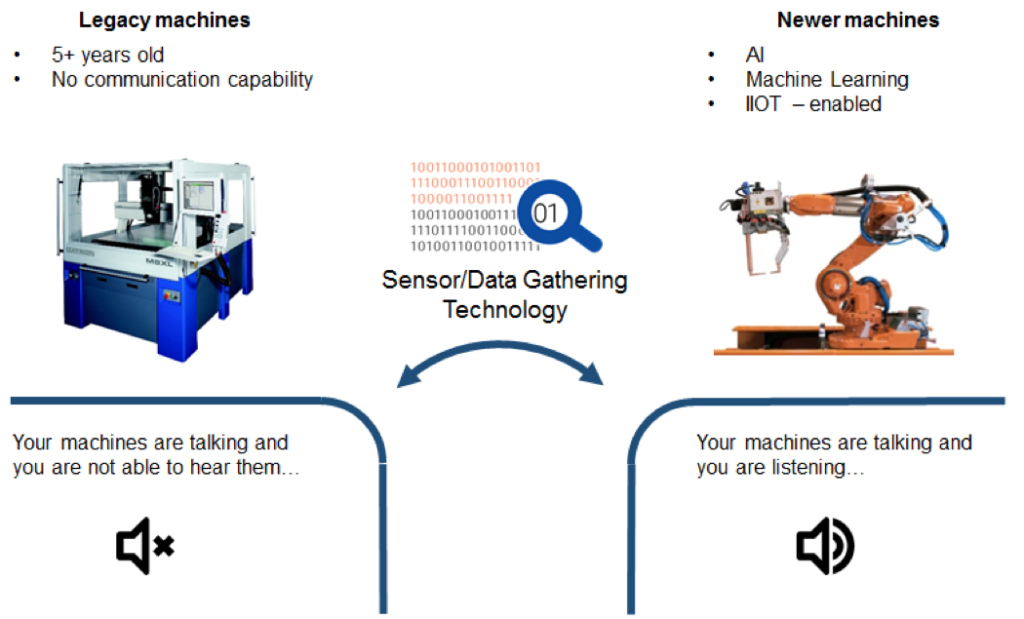How SMBs can adopt a “Survive and Thrive” strategy to upskill existing machinery
By Mike Watkins
Everywhere we look these days, we are bombarded by industrial Internet of things (IIoT) statistics, and the tremendous growth opportunity that it represents. By now, we can probably quote them verbatim –
- IDC projects there will be more than 30 billion connected “things” by 2020
- Grand View Research predicts that by 2025 the global IIoT market will have ballooned to $933.2 billion from just $116 billion in 2016
- Enterprises increased their investments in IoT by 4% in 2018 over 2017, spending an average of $4.6M
An average IIoT spend of $4.6M? Who can possibly spend $4.6M on IIoT? Now it is starting to make sense. All of these IIoT statistics are referring to large, enterprise level IIoT implementations.
When one considers the fact that small business is usually defined as organizations with less than $50 million in annual revenue, and that midsize enterprise is defined as organizations that make more than $50 million, but less than $1 billion in annual revenue, then a large enterprise must be an organization with more than $1 billion in annual revenue.
Approximately 6% of US companies account for more than 90% of IIoT spending today. If you are not a part of the 6%, then enterprise promises and statistics are probably not for you.
For most US manufacturers, $50M in annual revenue is a pipe dream, let alone more than $1 billion. So the answer to the question “who can possibly spend $4.6M on IIoT”, breaks down like this:
- 21% of the enterprises were $10M to <$500M in revenues
- 18% of the enterprises were $500M to < $1B in revenues
- 51% of the enterprises were >$1B in revenues
Combined, these three segments represented 90% of the enterprises that comprised the $4.6M average spend. Only 9% of enterprises were <$10M in revenue. Interestingly enough, a whopping 94% of all US companies have <$10M in revenues.
This tracks with U.S. Census Bureau, Statistics of U.S. Businesses, data that indicates that the vast majority of manufacturing firms in the United States are quite small. In 2015, there were 251,774 firms in the manufacturing sector, with all but 3,813 firms (1.5%) considered to be small (i.e., having fewer than 500 employees). In fact, three-quarters of the “small” firms had fewer than 20 employees.
The final analysis is approximately 6% of US companies account for more than 90% of IIoT spending today. If you are not a part of the 6%, then enterprise promises and statistics are probably not for you.
How to Embrace IIoT as an SMB
So, as a small to medium-sized business (SMB), what should you do? To do nothing is probably not a good strategy in this case. Certainly there is sensor technology in today’s machines that your company could benefit from. Of course, the problem is you have to purchase new machines in order to access that technology. Or do you?
There is an alternative strategy for SMBs. We refer to it as a “survive and thrive” strategy, because the owners of 98.5% of all manufacturing firms (the “small” firms) simply want their businesses to survive and thrive.
The following illustration graphically depicts the “survive and thrive” strategy.

It assumes that the business owner has legacy machines on the factory floor that are more than five years old. According to the Bureau of Economic Analysis, the average age of industrial equipment in the U.S. has gone up steadily over the last decade and now hovers at 10 years. So that is a good assumption.
Machines that are more than five years old have neither the sensor technology nor the versatile communications capability necessary to give users the ability to monitor, regulate, protect and improve their processes. Instead, these machines rely on human interpretation of status, which is a perception-based interpretation. Important functions such as troubleshooting and failure analysis can suffer from an individual looking at a machine and developing analyses and solutions. If you had five people looking at the same situation with the same equipment, you could very easily get five different interpretations and five different proposed solutions.
For business owners that have a combination of legacy machines and newer machines, it is almost as if they have two factory floors. A factory floor that is split between the machines that can tell their story and the machines that can’t. The machines that can, are able to very accurately tell the users what the problem is – and very possibly the sequence of events that led up to the problem. A “survive and thrive” strategy is one that addresses the split factor floor problem.
Survive and Thrive
Here is the bottom line: Disregard all the hype around IIoT expenditures. Large enterprise CIOs are compelled to pursue expensive, full-blown IIoT initiatives. They can’t risk missing the boat and it would be perceived as a breach of their fiduciary duty if they didn’t have an IIoT initiative underway. As an SMB manufacturer, you have two choices – you can purchase newer machines, or you can implement solutions that enables your legacy machines to gather similar data so that they too can talk to you, and so that you can listen.
Purchasing a new machine is expensive. In many instances, a five year old machine is still very capable, has many remaining years of useful life, and is already paid for. The only thing missing is the ability to gather data so that it can talk to you. The difference is $200K for a new machine versus $20K for a data gathering technology solution. Which one do you think is the best “survive and thrive” strategy for addressing the split factor floor?

